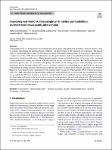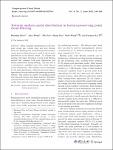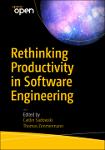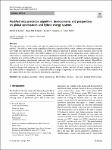Search
Author
- Jorgensen, Ed (3)
- McFadyen, Ron (3)
- Nora, El-Rashidy (3)
- Christian, Homeyer (2)
- next >
Subject
- programming (10)
- Open Access (8)
- Java (7)
- Programming (7)
- next >
Date issued
- 2020 - 2025 (293)
- 2010 - 2019 (39)
- 2000 - 2009 (2)
- 1999 - 1999 (1)
Has File(s)
- true (335)
Search Results
A wide range of signs are acquired from the human body called biomedical signs or biosignals, and they can be at the cell level, organ level, or sub-atomic level. Electroencephalogram is the electrical activity from the cerebrum, the electrocardiogram is the electrical activity from the heart, electrical action from the muscle sound signals referred to as electromyogram, the electroretinogram from the eye, and so on. Studying these signals can be so helpful for doctors, and it can help them examine and predict and cure many diseases. |
Virtual reality (VR) is a promising tool for training life skills in people with intellectual disabilities. However, there is a lack of evidence surrounding the implementation, suitability, and effectiveness of VR training in this population. The present study investigated the effectiveness of VR training for people with intellectual disabilities by assessing (1) their ability to complete basic tasks in VR, (2) real-world transfer and skill generalisation, and (3) the individual characteristics of participants able to benefit from VR training. Thirty-two participants with an intellectual disability of varying severity completed a waste management training intervention in VR that involved sorting 18 items into three bins. |
This open access book constitutes the 6 research workshops, the Agile Education and Training Track, the Doctoral Symposium, as well as a panel presented at XP 2020, the 21st International Conference on Agile Software Development, which was held during June 8-12, 2020. The conference was planned to take place at the IT University of Copenhagen, Denmark. Due to the COVID 19 pandemic, the conference was held online. In 2020, the following six workshops took place: Third International Workshop on Software-Intensive Business Eighth International Workshop on Large-Scale Agile Development Second European Symposium on Serverless Computing and Applications Second International Workshop on Agile Transformation First International Workshop on Agility with Microservices Programming Third Intern... |
While a popular representation of 3D data, point clouds may contain noise and need filtering before use. Existing point cloud filtering methods either cannot preserve sharp features or result in uneven point distributions in the filtered output. To address this problem, this paper introduces a point cloud filtering method that considers both point distribution and feature preservation during filtering. The key idea is to incorporate a repulsion term with a data term in energy minimization. |
Researchers are defining new types of interactions between humans and machine learning algorithms generically called human-in-the-loop machine learning. Depending on who is in control of the learning process, we can identify: active learning, in which the system remains in control; interactive machine learning, in which there is a closer interaction between users and learning systems; and machine teaching, where human domain experts have control over the learning process. Aside from control, humans can also be involved in the learning process in other ways. In curriculum learning human domain experts try to impose some structure on the examples presented to improve the learning; in explainable AI the focus is on the ability of the model to explain to humans why a given solution was ... |
The Monte Carlo method is a numerical technique to model the probability of all possible outcomes in a process that cannot easily be predicted due to the interference of random variables. It is a technique used to understand the impact of uncertainty, ambiguity, and risk in forecasting models. This book is organized into three sections and presents the general principles of the Monte Carlo method with an emphasis on techniques to decrease simulation time and increase accuracy. Section 1 discusses the major fields of application of the Monte Carlo method in medicine. Section 2 introduces the theory and application of the Monte Carlo method in material science. Section 3 provides practical information needed to support simulation and analysis of structures by numerical models and intr... |
The Chaos Game Optimization (CGO) has only recently gained popularity, but its effective searching capabilities have a lot of potential for addressing single-objective optimization issues. Despite its advantages, this method can only tackle problems formulated with one objective. The multi-objective CGO proposed in this study is utilized to handle the problems with several objectives (MOCGO). In MOCGO, Pareto-optimal solutions are stored in a fixed-sized external archive. In addition, the leader selection functionality needed to carry out multi-objective optimization has been included in CGO. The technique is also applied to eight real-world engineering design challenges with multiple objectives. The MOCGO algorithm uses several mathematical models in chaos theory and fractals inher... |
Get the most out of this foundational reference and improve the productivity of your software teams. This open access book collects the wisdom of the 2017 "Dagstuhl" seminar on productivity in software engineering, a meeting of community leaders, who came together with the goal of rethinking traditional definitions and measures of productivity. The results of their work, Rethinking Productivity in Software Engineering, includes chapters covering definitions and core concepts related to productivity, guidelines for measuring productivity in specific contexts, best practices and pitfalls, and theories and open questions on productivity. You'll benefit from the many short chapters, each offering a focused discussion on one aspect of productivity in software engineering. Readers in many... |
This paper provides a novel, unique, and improved optimization algorithm called the modified Orca Predation Algorithm (mOPA). The mOPA is based on the original Orca Predation Algorithm (OPA), which combines two enhancing strategies: Lévy flight and opposition-based learning. The mOPA method is proposed to enhance search efficiency and avoid the limitations of the original OPA. This mOPA method sets up to solve the global optimization issues. Additionally, its effectiveness is compared with various well-known metaheuristic methods, and the CEC’20 test suite challenges are used to illustrate how well the mOPA performs. |
In this work, we focus on outdoor lighting estimation by aggregating individual noisy estimates from images, exploiting the rich image information from wide-angle cameras and/or temporal image sequences. Photographs inherently encode information about the lighting of the scene in the form of shading and shadows. Recovering the lighting is an inverse rendering problem and as that ill-posed. Recent research based on deep neural networks has shown promising results for estimating light from a single image, but with shortcomings in robustness. |










